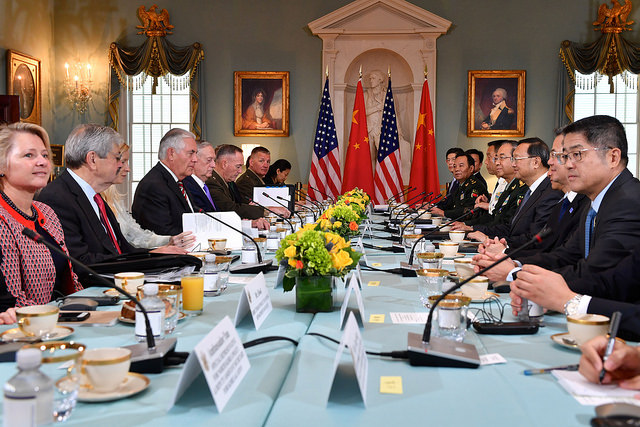Taking China Seriously on a North Korea Deal
With biannual joint U.S.-South Korea military exercises set to begin on Monday, the temperature on the Korean Peninsula has cooled, if only slightly, following a recent escalation in rhetoric between President Donald Trump and North Korean leader Kim Jong-un.

Published by The Lawfare Institute
in Cooperation With

With biannual joint U.S.-South Korea military exercises set to begin on Monday, the temperature on the Korean Peninsula has cooled, if only slightly, following a recent escalation in rhetoric between President Donald Trump and North Korean leader Kim Jong-un. As the nuclear brinkmanship recedes, we are left with a fundamental and unsettling new reality: North Korea possesses a credible capability to hit the U.S. homeland with a nuclear-armed missile.
Now comes a central question: In tandem with deterrence and containment, what can the United States do to bring North Korea to the negotiating table for serious discussions to limit and eventually roll back its nuclear program?

In recent days, China’s Foreign Ministry has doubled down on a longstanding proposal known as “double-suspension,” or “freeze-for-freeze,” as the best hope for a solution on the Korean Peninsula. North Korea would suspend its nuclear and missile testing in return for a suspension of U.S.-South Korean joint military exercises. This mutual forbearance is pitched by China (along with Russia) as a possible first step in bringing the parties to the table with the long-term goal of denuclearization.
At first blush, such a deal might seem to entail relatively little downside for the United States. The U.S. government could independently verify North Korean compliance on nuclear and missile testing, and the policy is quickly reversible should North Korea choose to cheat. Despite North Korea’s recently demonstrated intercontinental ballistic missile capability, the “get” for the United States is substantial because the lack of further flight testing would limit the North’s confidence in the technical reliability of its nuclear and missile technology. Moreover, leaders in both North Korea and South Korea have shown openness to the double-freeze as a pathway to negotiations.
But the United States has long resisted calls for a suspension of military exercises, which it correctly argues are lawful, defensive in nature, important for military readiness, and of “no moral equivalency” with the DPRK’s behavior. Some analysts fear that North Korea would simply use such an agreement to advance research and development for other aspects of its nuclear program—an especially weighty concern given reports of North Korea’s recent progress in miniaturizing nuclear warheads for ICBM delivery. Others worry that a halt in exercises would undermine confidence in the U.S.-South Korean alliance at a critical moment.
Despite these valid concerns, U.S. policymakers would do well not to dismiss the Chinese proposal out of hand. As U.S. leaders have acknowledged time and again, most recently in a Wall Street Journal op-ed by Secretary of Defense Jim Mattis and Secretary of State Rex Tillerson, China is a crucial player in the North Korean nuclear equation given its involvement in 90 percent of North Korean trade and its “dominant economic leverage over Pyongyang.” The approach of “strategic accountability” articulated by Mattis and Tillerson will have a chance at success only if China is willing to fully enforce the unprecedented economic sanctions to which it has agreed at the United Nations. Here is where a modified freeze proposal might have some room to run.
Instead of buying the proposal off the shelf as a Chinese-and-Russian-brokered deal between the United States and North Korea, U.S. officials could “accept” China’s proposal on the condition that China itself bring something to the table. That something would include specific steps to enforce existing economic sanctions and to curtail the financial channels on which North Korea’s weapons program relies. (An example would be going after the front companies and banks that provide illicit financing to North Korea’s government, including those that are less vulnerable to U.S. secondary sanctions due to their lack of exposure to the U.S. financial system.) Although recent months have seen an increase in Chinese cooperation at the U.N. Security Council—including full sectoral bans on North Korean exports of coal, iron and iron ore, lead and lead ore, and seafood under UNSC Resolution 2371—U.S. officials have considerable and justifiable concerns about China’s poor track record in following through with robust enforcement.
Thus, a possible deal: The United States and South Korea could agree to substantially scale back their March 2018 joint military exercises, on the condition that (1) North Korea immediately and completely suspend nuclear and ballistic missile testing, as well as exports of nuclear technology; and that (2) China crack down on North Korean trade, financial transfers, and cross-border movement of weapons technology in a scheduled step-by-step way that leads to a measurable increase in pressure on Pyongyang. The United States and South Korea would closely monitor each party’s compliance with the agreement for the next six months leading up to the spring exercises, and would only scale down the exercises if China held up its end of the bargain. A few scale-down scenarios could be drawn up—including, for example, limiting some command post exercises to a low-profile, computer-assisted format; moving certain exercises off the Korean Peninsula; or refraining from “decapitation” drills. If by the end of the six-month period China has not fully lived up to its commitments, the United States would have available a planned option commensurate with the extent of Chinese cooperation in the interim.
To be sure, even if North Korea were willing to go along with this proposal, there are reasons to think the Chinese government will be reluctant. China has prioritized maintaining a strategic “buffer state” on its border and worries about the possible collapse of the Kim regime. As a number of observers have noted, China is not confident it can thread the needle between pressure sufficient to bring North Korea to negotiations but not so severe that it causes regime collapse or outright war. China’s leaders thus find themselves on the horns of a dilemma when it comes to squeezing Pyongyang.
It is possible, however, that China may be amenable to a tougher approach going forward that explicitly builds on its own repeated proposals. Following North Korea’s recent missile tests, the Kim regime may feel more externally secure given the progress of its nuclear deterrent capability. China might calculate that this expands its margin of error to test the impact of a tighter economic squeeze. In addition, Chinese leaders understand that recent innovations in financial sanctions have made them a more nimble tool that can be targeted to avoid totally destabilizing the country.
The point here is not to suggest that a three-part deal with China and North Korea will necessarily work. Nearly any proposal designed to produce constructive negotiations with Kim’s regime must be viewed with an abundance of caution given the historical record and the fact that Kim sees nukes as essential to his survival. On almost any conceivable scenario, deterrence and containment will be cornerstones of U.S. strategy going forward.
Yet a deterrence and containment posture will require close coordination and cooperation, not only with our allies South Korea and Japan, but also with China—which will continue to have a strong interest in North Korean denuclearization. As former U.S. Secretary of State Henry Kissinger has argued, “An understanding between Washington and Beijing is the essential prerequisite for the denuclearization of Korea.” This necessarily includes U.S. recognition of China’s “stake in the political evolution of North Korea following denuclearization, whether it be a two-state solution or unification, and in restrictions on military deployment placed on North Korea.”
Reaching such an understanding will require a foundation of China-U.S. mutual trust that is far from established. The core of the proposal here is thus to take as the starting point of a new initiative China’s own “double-freeze” proposal, and build on it the modified terms outlined above. This would signal to Beijing that the United States does not dismiss Chinese proposals and concerns out of hand. It would provide a measure of moral high ground for the United States should China reject a U.S. counter-proposal that accepts the thrust of a much-touted Chinese diplomatic initiative. Above all, it would demonstrate that the United States is not spoiling for a fight but is serious about protecting its interests and not willing to give up an ounce of military readiness without getting something significant in return from the other major players at the table.
In sum, “freeze-for-freeze” alone is not a viable path to bringing North Korea to the table for serious negotiations. A key additional ingredient is Chinese leverage and increased pressure through economic sanctions. Although the “freeze-plus-pressure” arrangement sketched above is not in itself an answer to the fundamental security challenge on the Korean Peninsula, it may be one path toward a solution that currently eludes us.


.jpg?sfvrsn=407c2736_6)


